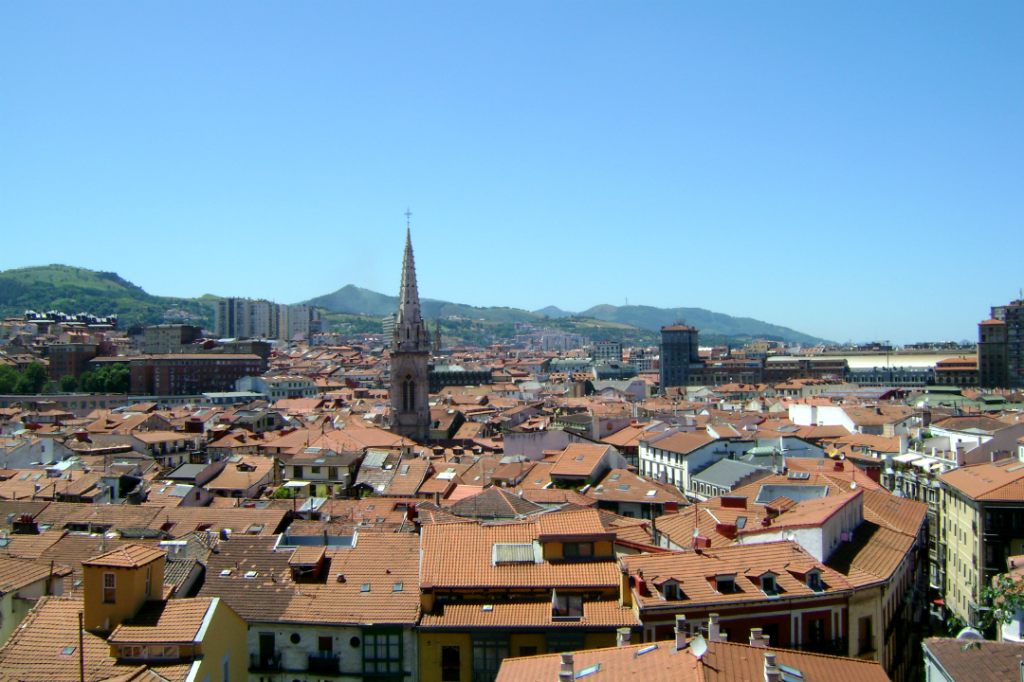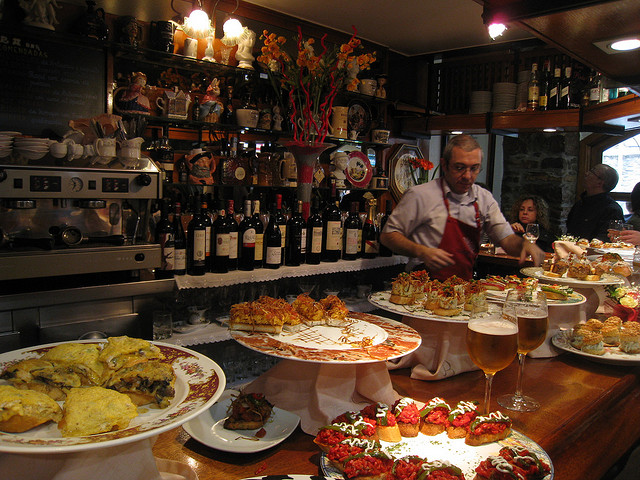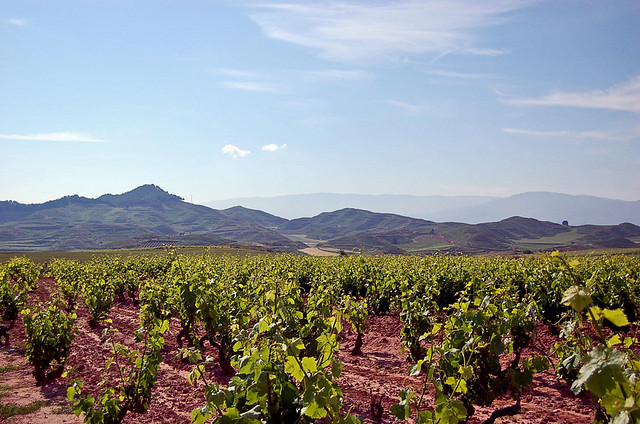As my plane touched down in northern Spain, on my way to Bilbao, I looked around at the jagged mountains, out over the Bay of Biscay and up at the clear, blue sky and thought to myself, "Dear God, I forgot people actually live in places like this."
It had been nearly 5 years since I'd last visited any part of Spain. In between, I had lived in flat, not very warm cities in Sweden, Latvia and Belgium. I had gotten too used to wearing sweaters in June and having an unobstructed panorama of the horizon.
That a Spanish coastal city is an idyllic place is not an epiphany someone should have to have more than once, yet here I was again, jaw on the tarmac.
Budget airline traffic in the area goes through Santander, so I still had 60 miles to go before I reached Bilbao. That meant I had a bus to catch. If the view of the area from the airport was enough to inspire, then the view from the road left me speechless: Swooping curves, inlet marshes and stony cliff faces that dropped straight into the Atlantic.
I would have to put Bilbao among the biggest surprises in all of my European travels. In this single regional city in the north of Spain, we found a paradise for foodies, luxury accommodation for about half the price we would have expected and multiple beaches accessible by the metro.
Yet, somehow, Bilbao had never made it onto my radar.
Here are some tips for making the most out of your trip to Bilbao.
Bilbao: An Introduction

Bilbao is the largest city in the Basque Country, a region rich in history, culture and geography that extends into southwestern France. Despite having a metropolitan population of nearly a million people, Bilbao is perhaps the fourth best-known Basque city after San Sebastian (a gastronomical powerhouse), Pamplona (with its annual San Fermin Festival and running of the bulls) and Guernica (whose destruction was the subject of one of Picasso's most famous works).
For much of the 19th and 20th centuries, Bilbao was the industrial center of the Basque Country, and it had enough sludge in its Nervion River to prove it. By the 1970s, though, the economy began to deindustrialize, and Bilbao was left with an old, run-down port it needed to do something with.
So, in 1991, the Basque government reached out to the Guggenheim Foundation and said, "We have this idea for a museum..."
Get introduced to the city on a Bilbao City Hop-on Hop-off Tour.
The Guggenheim and Its Impact

For many people, the Frank Gehry-designed Guggenheim Bilbao Museum is the centerpiece of a trip to Bilbao. Actually, that building might be the only reason some people have even heard of Spain's fifth-largest metropolis.
The museum features art from the mid-20th century to contemporary works, plus there is usually a temporary exhibit, as well. The museum is open from 10 am to 8 pm Tuesday through Sunday. In July and August, the museum also opens on Mondays with the same working hours. Ticket prices vary a bit depending on what special exhibits the museum is hosting at the time, but normal prices are 13 euros for adults, 7.50 euros for students younger than 26, and free for children younger than 12.
In all honesty, though, the architecture of the building itself is the primary draw, and the effect the museum has had locally is at least as noteworthy as the collection of art inside of it.
Urban planners today talk about the Bilbao Effect, which refers to investing in a piece of iconic architecture to give a city an easily identifiable landmark. The new landmark then attracts interest and tourism, spurring local development and economic growth.
In the 15 years since the Guggenheim Museum Bilbao was built, the city has seen tourism pump a net 200 million euros into the local economy, and Bilbao has made the transformation from an industrial port town to a sophisticated cosmopolitan city.
In fact, that transformation has been so complete that I still found it hard to believe someone actually had to pressure wash soot off the facades along the Gran Via, one of the city's major streets, within my lifetime. It's all so pristine today.
Read more: Bilbao: From Provincial Town to Art Star
Indulge in the Basque Cuisine

One major effect of this transformation has been that Bilbao has begun to play catchup to San Sebastian's gastronomy scene. Until recently, Bilbao had been forever overshadowed by its neighbor to the east--which boasts two of the world's best restaurants--despite the fact that the two cities shared many of the same culinary traditions. Today, though, "Bilbao" and "art" are often pronounced in the same breath, and this seems to have given local chefs the confidence to express their creativity.
Any culinary exploration of the Basque Country demands special attention be paid to pintxos, essentially Basque tapas. Bar El Globo , near the Moyua metro stop, serves up some of the best I've ever had; favorites included peanut-coated black pudding and curry-fried bananas. If you get particularly hungry, the pintxos bar-hopping is excellent along the street Maestro Garcia Rivero. Start at El Huevo Frito and ask for the chipirones en su tinta, or baby squids cooked in their own ink.
If you prefer not to stand along a bar counter while you dine, Bilbao has you more than covered, as well. Zortziko, Etxanobe and the Guggenheim Bilbao's own Nerua each boast a Michelin star for their modern cuisines. Restaurante Mina, in a humble neighborhood auspiciously across from the riverside market, can accommodate no more than 30 people but has steadily collected a long list of glowing reviews. Finally, Bascook embraces playfulness at the table with its tabloid newspaper menu and a gin and tonic desert with jelly cubes.
Don't Forget Drinks

Bilbao is in the middle of the Basque wine-making region, which itself borders two other wine-making regions: Navarre and La Rioja. That means wine in Bilbao is plentiful and, by the glass, often a cheaper option than a Coke.
The Rioja region is most famous for its red wines, the Navarre region initially for its rosé, but its whites are not bad, either. But it's when you get to the local wines that you start to experience some new and unusual tastes. The Basques have a semi-sparkling white wine called txacoli that can be staggeringly acidic on the tongue. If you've never heard of this wine before, it might be because the locals drink it almost all up, leaving little for export.
Bar El Globo, again, served as my testing area. They had wines by the glass from all three regions, none of which they charged more than 2 euros for. I found the sour acidity of the txacoli went well with the pintxos that had sheep cheese or goat cheese, and it probably paired well with much of the local seafood, too.
Finally, if you visit between late January and late April, you will be just in time for cider season. Basque cider is flat, poured from height (hold the bottle high above your head) and consumed in great quantities. During the season, you can order a fixed-price menu of food and all the cider you can drink at any of the sagardotegias, or cider houses, in the region. Bilbao has one, Artxanda Sagardotegia, on top of the Artxanda mountain on the northeast side of the city, accessible by funicular.
Sample local wine on a tour through Vitoria and the Rioja Wine Region and read more about Wine Tasting in the Rioja Region of Spain.
Get Out

What really sold me on Bilbao, though--and what had me checking apartment prices throughout the week--was the nature around it. The city lies at the end of an inlet where the sea has punched out a valley between the Cantabrian and Pyrenees mountain ranges. Green, angular hills form a ring around the city, and just to the north lies the Bay of Biscay.
You can get a good lay of the land with the Artxanda funicular, across the river and just upstream from the Guggenheim. The trip uphill takes just a few minutes, and you can use a metro or bus pass to board the funicular. The view from the top southward across the city is a nice one, but if you turn around and walk through the park, you should be able to see the ocean, just a few miles upriver.
Better still, the ocean is itself accessible by metro. At the end of Line 1 is Plentzia, a beach very popular with the locals and a great spot for sunbathing and swimming. The beach lies safely inside an inlet, with a couple of walls to break the waves down to manageable sizes, but a glimpse at the rock faces enveloping the beach should hint at the ferocity the sea is capable of here.
A ferocious sea means great surfing. The beach at Meñakoz is accessible by metro, at the Sopelana stop, but only advanced surfers should give the waves here a go. For intermediate surfers, check out Bakio, just eastward along the coast and accessible by the regional bus system.
Get out in a unique way on a Scenic Flight of Bilbao and The Basque Coast and read more about things to do in Spain.
-- Eric Barrier
Planning a trip? Browse Viator's Basque Country tours and things to do, Basque Country attractions, and Basque Country recommendations. Or book a private tour guide in Bilbao for a customized tour!